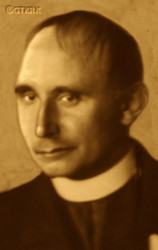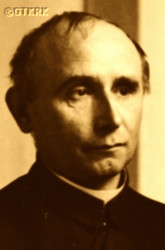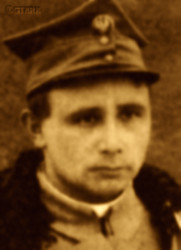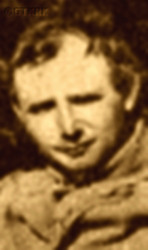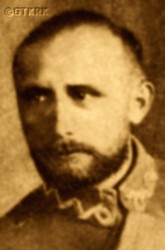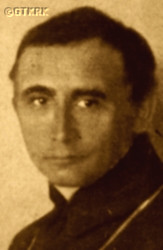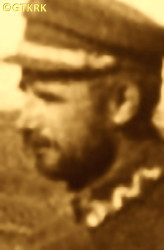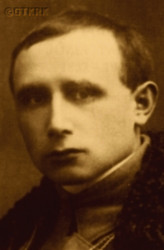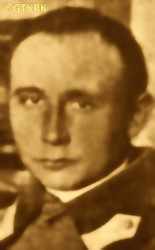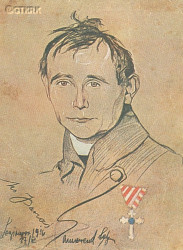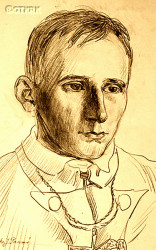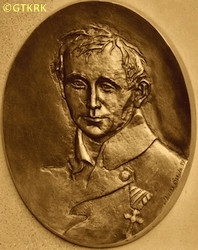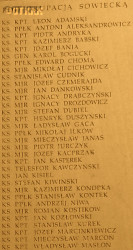Roman Catholic
St Sigismund parish
05-507 Słomczyn
85 Wiślana Str.
Konstancin deanery
Warsaw archdiocese, Poland
full list:
displayClick to display full list

searchClick to search full list by categories
wyświetlKliknij by wyświetlić pełną listę po polsku

szukajKliknij by przeszukać listę wg kategorii po polsku

Martyrology of the clergy — Poland
XX century (1914 – 1989)
personal data
surname
PANAŚ
forename(s)
Joseph (pl. Józef)
function
diocesan priest
creed
Latin (Roman Catholic) Church RCmore on
en.wikipedia.org
[access: 2014.09.21]
diocese / province
Przemyśl diocesemore on
www.przemyska.pl
[access: 2013.02.15]
RC Military Ordinariate of Polandmore on
en.wikipedia.org
[access: 2014.12.20]
honorary titles
War Order of Virtuti Militari — Silver (5th Class)more on
en.wikipedia.org
[access: 2019.10.13]
(11.11.1942, No._13480, granted by General Stephen Grot-Rowecki, commander of the Home Army AK)
Expositorii Canonicalis canonmore on
en.wikipedia.org
[access: 2014.11.14]
(c. 1920)
War Order of Virtuti Militari — Silver (5th Class)more on
en.wikipedia.org
[access: 2019.10.13]
(04.10.1922)
„Polonia Restituta” Cross — 4th Class, Officer'smore on
en.wikipedia.org
[access: 2019.04.16]
(02.05.1922)
Lviv Defense Cross
„Przemyśl Star” Badge
Merit Cross for Military Chaplains 2nd Class Silver (Austro–Hungarian Empire)more on
en.wikipedia.org
[access: 2023.12.15]
(1916)
„Cross of Valour”more on
en.wikipedia.org
[access: 2019.04.16]
date and place
of death
04.04.1940

Lvivtoday: Lviv urban hrom., Lviv rai., Lviv obl., Ukraine
more on
en.wikipedia.org
[access: 2022.01.16]
alt. dates and places
of death
04.1940
NKVD Katynholiday resort
form.: Kozye Gory forest
today: Smolensk reg., Smolensk oblast, Russia
more on
en.wikipedia.org
[access: 2020.09.24]
details of death
After the outbreak of World War I, 30.08.1914, provision officer of the 4th Battalion, and then chaplain of the 2nd Infantry Regiment of the Eastern Legion (Austro–Hungarian Monarchy's Army). Then chaplain of the 3rd Infantry Regiment, from 05.1915 in the 2nd Brigade of the Polish Legions (on 13.06.1915 with the Regiment took part in the famous charge at Rokitna in Bukovina against Russian troops). Next, head of the RC pastoral department of the Polish Legions in the Austro–Hungarian Monarchy's Army (from 09.08.1915), and Roman Catholic field superior of the Roman Catholic military chaplaincy in the Army of the Austro–Hungarian Monarchy in Warsaw (from 12.1916). Participant in many battles and skirmishes of the 2nd Brigade with the Russians (including from mid‐1915 in Volyn; at the end of 1917 — as part of the Polish Auxiliary Corps PKP — on the Bukovina–Bessarabia front).
In 11.1915 wounded in a clash near Kostiuchnówka in Volyn.
During the so‐called oath crisis of 09‐11.07.1917, supported, together with the 2nd Brigade within the PKP, taking an oath of allegiance to the German emperor — contrary to the recommendation of Brigadier Joseph Piłsudski.
After signing the peace treaty in Brest on 09.02.1918 between the Central Powers (the German and Austro–Hungarian Empires) and the so‐called Ukrainian People's Republic — bypassing the Poles — which assumed the creation of a Ukrainian state, including, among others, Chełm region, during the funeral of a soldier of the 2nd Brigade, said, among other things: „Brothers, let us raise our hearts to God and all together at this coffin take a holy oath of unconditionally faithful service to our Polish Homeland and let it resound today from all breasts with the song of the oath that is on the lips of the entire Polish nation: «We will not give up the land from which our origins come»”. A few days later, the PKP and the 2nd Legion Brigade, which was part of it, in protest against the provisions of the Treaty, renounced obedience to the Austro–Hungarian command and on 15‐16.02.1918 near Ridkivtsi attempted to break the front line and cross over to the Russian side. Captured by the Austrians and accused of mutiny.
Interned in Khust in Transcarpathia, then in Hungary. On 08.06.1918 tried in Marmaroschsiget — today Sighetu Marmației — as was one of the three main defendants. In his defense speech said, i.a.: „We were […] all certain that for many years of hardship, for hunger, cold, toil and blood so abundantly shed — the Austrian authorities, after committing terrible wrongs on us, would at least leave us a free path, which […] was necessary for us to save at least our soldierly honor […] What the mood was among […] is evidenced by the fact that the young, dying legionnaire did not ask me to write a letter with the last words to his mother, but asked: «Father, I am dying, but please tell me, will there be Poland?»”. On 02.10.1918 pardoned however by the decision of Emperor Charles I of Habsburg and released (the Austrian general advised him then to „never hit his head against the wall, because he won't break it”, to which he allegedly replied: „Mr General, I have been banging my head against the wall for four years, and yet my head is intact, but the wall is collapsing”.
On 11.11.1918, the Austro–Hungarian Empire fell, the World War I ended, and Poland regained independence.
Organizer and participant of the battles against Ukrainians for Przemyśl in 11.1918 and next — as part of the „San” operational group, which actually on 05‐10.11.1918 commanded and which entered Przemyśl on 11.11.1918 — for the liberation and then, until 05.1919, the defense of Lviv. One of the main initiators of the creation of the Lviv Eaglets Cemetery.
During the Polish–Russian war of 1919‐1921, dean of the Supreme Command of the Polish Army NDWP, i.e. Army „East”, in Eastern Galicia, and then the Command of the General District DOG „Lviv”. On 17.08.1920, took part, among others, in the battle with Russian troops of the 1st Cavalry Army of General Semyon Budyonny near Zagórze.
After the end of the wars for Polish borders, commissioned military chaplain.
On 17.05.1926, in the garrison church in Warsaw, after a service for those who died in battles during the May coup d'état in Poland, said: „I have sinned gravely, because I almost idolatrously worshipped and believed in Piłsudski's righteousness and soldierly honesty, but the just Lord punished me for it, because today I have to look at the greatest crime in the world committed by Piłsudski. These orders, which have so far adorned my chest, namely: the Virtuti Militari Cross V class, received for the defense of Przemyśl, the Polonia Restituta Officer's Cross, received for organizing […] the 2nd Brigade against Austria, the Battle of Rarańcza and [defense…] of a Polish soldier in the trial in Marmaroschsiget; […] the Cross of Valor for merits in the Polish Legions [during the] Bolshevik war — received from Piłsudski, [filled me with] pride. Today, after this crime that he committed […] I am tearing them off […] because they have been disgraced”. And threw them on the floor of the garrison church. On 18.08.1926 dismissed from his dean position in Przemyśl. On 30.09.1927 retired.
From 26.12.1931 to 13.01.1932 defense witness in the so‐called the Brest trial, in which the ruling Sanation authorities accused several opposition activists of preparing a coup.
After German and Russian invasion of Poland in 09.1939 and start of the World War II, after start of Russian occupation, hid the fund entrusted to him by the parliamentary People's Party SL in the basement of the Dominican church in Lviv.
Joined the Polish independence resistance movement of the Armed Struggle Union ZWZ (part of the later Polish Clandestine State), under nom‐de‐guerre „Plowman”. As a representative of the People's Party SL, at the turn of 1939/1940 became a member of the Political Committee in the Social and Political Department of the ZWZ‐1 Lviv Area Command. Was also a member of the treasury committee at the ZWZ‐1 HQ of Area No. 3 in Lviv.
At the turn of 03‐04.1940, appointed as a courier to the headquarters of the Prime Minister of the Polish Government, Gen. Vladislav Sikorski, in Angers, France, where was to report on Russian activities in the occupied areas of eastern Poland.
Did not complete this mission. In 12.1939, was arrested by the Russians for the first time, but was not recognized and released in the same month. However, on 04.04.1940 was not so lucky, and in Kozin near Halych, during mass arrests of members of the Lviv ZWZ Command, arrested by the Russians again.
Held in Halych, and then in Lviv.
Tortured.
Perished in unclear circumstances — prob. thrown out from the 2nd or 3rd floor of the prison in Lviv, the NKVD building at Pełczyńska Str. when being taken for questioning.
Some of the ZWZ members arrested in Lviv were later tried in the so‐called „Trial of the Fourteen”.
alt. details of death
According to some sources jailed in Kozielsk concentration camp. From there transported to Katyń execution site and brutally murdered.
cause of death
mass murder
perpetrators
Russians
sites and events
Lviv (Brygidki)Click to display the description, NKWD KatynClick to display the description, «Katyn genocide 1940»Click to display the description, KLW KozelskClick to display the description, Trial of 19‐20.11.1940Click to display the description, Lviv (Zamarstiniv)Click to display the description, Ribbentrop‐MolotovClick to display the description, Pius XI's encyclicalsClick to display the description, Polish‐Russian war of 1919‐1921Click to display the description, Polish‐Ukrainian war of 1918‐1919Click to display the description
date and place
of birth
23.11.1887Birth certification on:
skanoteka.genealodzy.pl
[access: 2025.04.13]

Odrzykońtoday: Wojaszówka gm., Krosno pov., Subcarpathia voiv., Poland
more on
en.wikipedia.org
[access: 2021.10.09]
parents
PANAŚ Simon
🞲 ?, ? — 🕆 ?, ?

GUZEK Thecla
🞲 ?, ? — 🕆 ?, ?
baptism
23.11.1887Birth certification on:
skanoteka.genealodzy.pl
[access: 2025.04.13]

Odrzykońtoday: Wojaszówka gm., Krosno pov., Subcarpathia voiv., Poland
more on
en.wikipedia.org
[access: 2021.10.09]
St Catherine the Virgin and Martyr RC church
presbyter (holy orders)
ordination
29.06.1911

Przemyśltoday: Przemyśl city pov., Subcarpathia voiv., Poland
more on
en.wikipedia.org
[access: 2021.04.01]
positions held
1927 – 1939
resident — Lvivtoday: Lviv urban hrom., Lviv rai., Lviv obl., Ukraine
more on
en.wikipedia.org
[access: 2022.01.16] — also: for a while in Katowice (c. 1928‐1929), Grudziądz (c. 1930), Tuszewo n. Grudziądz (c. 1934), Kozin n. Jezupol (c. 1937)
1933 – 1939
chaplain — Haller's Boys Association — member of the Executive Board
1931 – 1939
membership — Chief Council, People's Party
1930 – 1931
membership — Chief Council, Polish People's Party PSL „Piast”
1930 – 1934
editor — „Grudziądz Newspaper”
1927 – 1929
teacher — Lvivtoday: Lviv urban hrom., Lviv rai., Lviv obl., Ukraine
more on
en.wikipedia.org
[access: 2022.01.16] ⋄ Henry Jordan's Private Secondary School of Humanities
1928 – 1929
membership — Chief Executive Committee, People's Party
from 1927
retired (i.e. „at rest”) — Polish Armed Forces — after the public protest against Marshal Joseph Piłsudski's Coup in 05.1926
1921 – 1926
RC military dean — Command of the Corps District DOK No. X Przemyśl, Polish Armed Forces — acting („ad interim”)
1922 – 1926
RC military pastor — Przemyśltoday: Przemyśl city pov., Subcarpathia voiv., Poland
more on
en.wikipedia.org
[access: 2021.04.01] ⋄ garrison, Command of the Corps District DOK No. X Przemyśl, Polish Armed Forces ⋄ Sacred Heart of Jesus RC military parish — by decree of the Chief of State of 03.05.1922, confirmed with seniority from 01.06.1919 and 9th place on the list of Roman Catholic military pastors, in the rank of lieutenant colonel; by decree No. L. 3448 of the Commander‐in‐Chief of 16.12.1921, verified with seniority from 01.04.1920 and 10th place on the list of Roman Catholic military pastors, in the rank of lieutenant colonel; also: administrator of the military parish
1923 – 1925
curatus/rector/expositus — Pikulicetoday: Przemyśl gm., Przemyśl pov., Subcarpathia voiv., Poland
more on
en.wikipedia.org
[access: 2021.12.18] ⋄ Sacred Heart of Jesus and Bl. James Strema of Strzemię coat of arms RC church ⋄ Przemyśltoday: Przemyśl city pov., Subcarpathia voiv., Poland
more on
en.wikipedia.org
[access: 2021.04.01], Assumption of the Blessed Virgin Mary and St John the Baptist RC cathedral parish ⋄ Przemyśl citydeanery name
today: Przemyśl city pov., Subcarpathia voiv., Poland RC deanery — acting („ad interim”)
1921
RC military chaplain — Bishop's Curia of the Polish Military, Polish Armed Forces — member of the Verification Commission for the Clergy of the Catholic Faith, established on 12.03.1921 by the L.2743 decree of the Commander‐in‐Chief, preparing a list of seniority and a proposal for the appointment of Catholic chaplains from former armies of partitioning powers, Polish Legions, Eastern Corps, General Haller's Army and chaplains of the Greek Catholic rite, to officer ranks
1919 – 1921
RC military chaplain — Command of the General District DOG „Lviv”, Polish Armed Forces — titular dean
1918 – 1919
RC military chaplain — Supreme Command of the Polish Armed Forces for Eastern Galicia NDWP, i.e. Army „Wschód”, Polish Armed Forces — titular dean
1917 – 19.02.1918
RC military chaplain — Polish Auxiliary Corps, Austro–Hungarian Imperial Army
12.1916 – 1917
RC field superior — Warsawtoday: Warsaw city pov., Masovia voiv., Poland
more on
en.wikipedia.org
[access: 2021.10.09] ⋄ RC military chaplaincy, Austro–Hungarian Imperial Army — reconstruction manager of the RC garrison church (today military cathedral)
1915 – 1916
RC military chaplain — command, Polish Legions (part of the Austro–Hungarian Landsturm), Austro–Hungarian Imperial Army — head of the RC pastoral department; from 09.08.1915 in the rank of captain of the Imperial Austro–Hungarian Army
1914 – 1915
RC military chaplain — 2nd Brigade, known as Carpathian or Steel, Polish Legions (part of the Austro–Hungarian Landsturm), Austro–Hungarian Imperial Army — from 16.10.1914 in the rank of second lieutenant and next from od 11.12.1914 in the rank of lieutenant
1914
priest — (Duchy of Anhalt territory)today: Saxony‐Anhalt state, Germany
more on
en.wikipedia.org
[access: 2020.11.27] ⋄ seasonal workers
c. 1914 – c. 1916
prefect — Dobromyltoday: Dobromyl urban hrom., Sambir rai., Lviv obl., Ukraine
more on
en.wikipedia.org
[access: 2021.10.09] ⋄ Transfiguration of the Lord RC parish ⋄ Dobromyltoday: Dobromyl urban hrom., Sambir rai., Lviv obl., Ukraine
more on
en.wikipedia.org
[access: 2021.10.09] RC deanery — public school for boys
c. 1913
vicar — Dobromyltoday: Dobromyl urban hrom., Sambir rai., Lviv obl., Ukraine
more on
en.wikipedia.org
[access: 2021.10.09] ⋄ Transfiguration of the Lord RC parish ⋄ Dobromyltoday: Dobromyl urban hrom., Sambir rai., Lviv obl., Ukraine
more on
en.wikipedia.org
[access: 2021.10.09] RC deanery
1911 – c. 1912
vicar — Dublianytoday: Novyi Kalyniv urban hrom., Sambir rai., Lviv obl., Ukraine
more on
en.wikipedia.org
[access: 2021.10.09] ⋄ St Nicholas the Bishop and Confessor RC parish ⋄ Drohobychtoday: Drohobych urban hrom., Drohobych rai., Lviv obl., Ukraine
more on
en.wikipedia.org
[access: 2021.10.09] RC deanery — also: prefect of vocational school
1907 – 1911
student — Przemyśltoday: Przemyśl city pov., Subcarpathia voiv., Poland
more on
en.wikipedia.org
[access: 2021.04.01] ⋄ philosophy and theology, Theological Seminary
publicist — author of i.a. „Memoirs of the chaplain of the Polish Legions”, Lviv 1920; „Hard days of Przemyśl. Chronicle notes of an eyewitness”, Lviv 1920; „Rarańcza – Huszt – Marmarosz‐Sziget”, Lviv 1928; „We, the 2nd Brigade”, Katowice 1929
others related
in death
BOGDANOWICZ–ROSZKOClick to display biography Adam Henry, KANIAKClick to display biography Michael Augustus (Fr Ceslav), KISIELClick to display biography John, ALEKSANDROWICZClick to display biography Anthony, CHOMAClick to display biography Edward Anthony, CICHOWICZClick to display biography Nicholas, DRABCZYŃSKIClick to display biography Ignatius Marian (Cl. Dominic), FEDOROŃKOClick to display biography Simon, ILKÓWClick to display biography Nicholas, KONTEKClick to display biography Stanislav, POHORECKIClick to display biography John, POTOCKIClick to display biography John Josaphat, SUCHCICKIClick to display biography Casimir, URBANClick to display biography Vladislav Michael, ZIÓŁKOWSKIClick to display biography John Leo
sites and events
descriptions
Lviv (Brygidki): Penal prison, then at 34 Kazimierzowska Str. in Lviv — in the buildings of the former monastery of the Order of St Brigid, in 1784 — after the first partition of Poland and after the dissolution of the religious orders as part of the so—called Josephine dissolutions — converted by the partitioning Austrian authorities into a prison. In 1939‐1941, the Russians held there thousands of prisoners, most of them Poles. On c. 26.06.1941, in the face of the German invasion and attack of their erstwhile ally, the Russians, during a panic escape (the left Lviv exactly on 26.06.1941), genocideally murdered several thousand prisoners. In 1941‐1944 the prison was run by the Germans and mass murders of Polish, Jewish and Ukrainian civilians took place there. After start of another Russian occupation in 1941 prison in which the executions were carried out on prisoners sentenced to death. (more on: en.wikipedia.orgClick to attempt to display webpage
[access: 2014.09.21])
NKWD Katyn: From 03.04.1940 till 12.05.1940 Russians in a planned genocide executed in Katyn c. 4,400 Polish POWs kept in KLW Kozelsk concentration camp in Kozelsk. This genocide was the implementation of the decision of the Russian Commie‐Nazi authorities — the Politburo of the Russian Commie‐Nazi party — of 05.03.1940 to exterminate tens of thousands of Polish intelligentsia and servicemen, held in Russian camps established after the German‐Russian Ribbentrop‐Molotov Agreement and the annexation of half of Poland by the Russians in 1939, known as «Katyn genocide». After the formal „verdict”, the NKVD Special Council Moscow, i.e. the genocidal Russian kangaroo court known as the «NKVD Troika», sent successive disposition letters to the NKVD in Smolensk — there were c. 46 of them — containing the names of the persons to be murdered. The victims were brought by train through Smolensk to the Gnezdowo station in convoys, in groups of 50 to 344 people. From the station to the crime scene, in the so‐called the Kozye Hory area —NKVD recreation center — the victims were transported in a prison bus (known as „chornyi voron”, i.e. black crow). At the site the younger and stronger had military coats put over their heads and their hands were tied behind their backs with a Russian‐made hemp rope, after which they were all killed at short distance with a shot from a 7.65 mm Walther pistol, usually one to the back of the head. Some victims were pierced with a square Russian bayonet. A number of the victims were prob. murdered in the basements of the so‐called internal prison of the NKVD Regional Directorate in Smolensk, where the victims were placed in a sewer manhole, their heads were placed on the bank, and then they were shot in the back of the head. The murdered were buried in eight pits ‐ mass graves. The victims included, among others: Rear Admiral Xavier Czernicki, Generals Bronislav Bohatyrewicz, Henry Minkiewicz and Mechislav Smorawiński, the Chief Orthodox Chaplain of the Polish Army, Lieutenant Colonel Simon Fedorońko, the Chief Rabbi of the Polish Army, Major Baruch Steinberg, 9 Roman Catholic priests, one Greek Catholic and one Evangelical priest, as well as one woman — a pilot Second Lieutenant Janine Lewandowska. (more on: pl.wikipedia.orgClick to attempt to display webpage
[access: 2012.11.23], en.wikipedia.orgClick to attempt to display webpage
[access: 2014.09.21])
«Katyn genocide 1940»: 05.03.1940, the Russian Commie‐Nazi authorities — the Politburo of the Russian Commie‐Nazi party headed by Joseph Stalin — made a formal, secret decision No. P13/144 to exterminate tens of thousands of Polish intelligentsia and military personnel, „declared and hopeless enemies of the Russian government”, held in Russian camps, as a consequence of the German‐Russian Ribbentrop‐Molotov Agreement, the invasion of Poland and annexation of half of Poland in 09.1939, and the beginning of World War II. The decision was, as it were, „sanctioned” by the verdicts of the NKVD Special Council, i.e. the genocidal Russian kangaroo court known as «NKVD Troika» in Moscow. The implementation in Ukraine and Belarus was made possible by order No. 00350 of 22.03.1940 of the head of the NKVD, Lavrentiy Beria, on the „unloading of NKVD prisons”, i.e. transfer of prisoners from several prisons in Ukraine and Belarus to central prisons, e.g. in Kiev or Minsk. The genocidal «NKVD Troika», after issuing sentences, also sent to local NKVD units, NKVD disposition lists — i.e. lists of convicts — each containing on average c. 100 names. Named lists are known — may be reconstructed — for people held in the KLW Kozelsk and KLW Ostashkov camps, but not for KLW Starobilsk, known for victims from Ukrainian prisons, but not Belarusian ones. It is not even known exactly how many lists there were, mainly because the number of them sent to the NKVD in Belarus is unknown. On 03.03.1959 Alexander Shelepin, then head of the Russian KGB, in a handwritten note stated: „ Since 1940, the Committee for State Security under the Council of Ministers of Russia, has been keeping records and other materials relating to the prisoners of war and interned officers, gendarmes, policemen, etc., people from former bourgeois Poland shot that year. In total, based on the decision of the special troika of the NKVD of the USSR, 21,857 people were shot, of whom: 4,421 people in the Katyn Forest (Smolensk Oblast), 3,820 people from the Starobilsk camp near Kharkov, 6,311 people from the Ostashkov camp (Kalinin Oblast), and 7,305 people in other camps and prisons in Western Ukraine and Western Belarus. The entire operation of liquidation of the above–mentioned was carried out on the basis of the Resolution of the Central Committee of the CPSU of 05.03.1940”. The head of the NKVD recommended to the Russian leader, Nikita Khrushchev, to destroy all personal files of those shot in 1940, but to keep the minutes of the meetings of the «NKVD Troika» and confirmations of the implementation of the decisions of the «NKVD Troika». A one–sentence draft resolution was attached to the note. It is not known whether the resolution was accepted and whether the files were destroyed. The aforementioned protocols and confirmations of the «NKVD Troika» are also not known. There are indications — i.e. four so‐called „NKVD‐Gestapo Methodical Conferences” of 1939‐1940: in Brest on Bug, Przemyśl, Zakopane and Cracow — of close collaboration between Germans and Russians in realization of plans of total extermination of Polish nation, its elites in particular — decision that prob. was confirmed during meeting of socialist leaders of Germany: Mr Heinrich Himmler, and Russia: Mr Lavrentyi Beria, in another German leader, Mr Hermann Göring, hunting lodge in Rominty in Romincka Forest in East Prussia. (more on: en.wikipedia.orgClick to attempt to display webpage
[access: 2023.12.15])
KLW Kozelsk: Russian Rus. Концентрационный Лагерь для Военнопленных (Eng. POW Concentration Camp) KLW, run by genocidal Russian NKVD organization, for Poles arrested after the invasion in 1939, operating in 1939‐1940 in Kozelsk — on the premises of the 18th century Orthodox Stauropygial Introduction of the Mother of God into the Temple Optyn Monastery, shut down and robbed by the Russian Bolsheviks in 1923. In 04‐05.1940, c. 4,594 people were detained there, who were then — as part of the implementation of the decision of the Russian authorities to exterminate dozens thousands of Polish intelligentsia and military personnel — murdered in Katyn. The prisoners included one rear admiral of the Polish Navy, four generals, c. 100 colonels and lieutenant colonels, c. 300 majors and c. 1,000 captains and captains of the Polish Army. Around half of them were reserve officers, including: 21 professors, associate professors and lecturers at universities, over 300 doctors, several hundred lawyers, several hundred engineers, several hundred teachers and many writers, journalists and publicists. There was also one woman, 2nd Leutenant pilot Janine Lewandowska. (more on: pl.wikipedia.orgClick to attempt to display webpage
[access: 2012.11.23])
Trial of 19‐20.11.1940: In 03.1940 till 06.1940 Russians arrested in Lviv hundreds of members of an emerging Polish clandestine resistance Armed Struggle Union ZWZ organization (part of later Polish Clandestine State). They were held in Lviv prisons. Tortured (special fame earned Russian genocidal NKVD sadistic member, J. M. Libenson of Jewish origin). 14 of them were tried in Zamarstynów prison during the night of 19‐20.11.1940, before a «NKVD Troika» — a murderous Russian court. Prosecuted Mr Nowicki, Ukrainian. All stated that they were proud members of ZWZ. At 02:00 in the morning 13 of them were sentenced to death, among them two priests. One, as a juvenile, got 10 years in Russian concentration camps Gulag (and perished there, prob. in Kołyma). On 11.12.1940 Russian Kiev prosecutors’ office „did not endorse cassation applications” (one of the condemned, Fr Bogdanowicz, wrote his in Polish!). On 21.12.1940 the Criminal College at Supreme Court in Kiev upheld most of the sentences. Finally on 17.02.1941 all sentences were upheld by Russian Supreme Court in Moscow. All condemned in this „trial of the fourteen” were thus executed by the Russians, prob. Katyń style, with a shot to the back of the head. (more on: www.google.plClick to attempt to display webpage
[access: 2017.01.21])
Lviv (Zamarstiniv): Penal prison no 2 in Lviv. In 1939‐1941 Russians organised there an NKVD detention centre and jailed thousands of prisoners, mainly Poles and Ukrainians, interrogating them and torturing. In 06.1941 after German invasion Russians murdered few thousands of them in a mass massacre. (more on: pl.wikipedia.orgClick to attempt to display webpage
[access: 2015.09.30])
Ribbentrop‐Molotov: Genocidal Russian‐German alliance pact between Russian leader Joseph Stalin and German leader Adolf Hitler signed on 23.08.1939 in Moscow by respective foreign ministers, Mr. Vyacheslav Molotov for Russia and Joachim von Ribbentrop for Germany. The pact sanctioned and was the direct cause of joint Russian and German invasion of Poland and the outbreak of the World War II in 09.1939. In a political sense, the pact was an attempt to restore the status quo ante before 1914, with one exception, namely the „commercial” exchange of the so‐called „Kingdom of Poland”, which in 1914 was part of the Russian Empire, fore Eastern Galicia (today's western Ukraine), in 1914 belonging to the Austro‐Hungarian Empire. Galicia, including Lviv, was to be taken over by the Russians, the „Kingdom of Poland” — under the name of the General Governorate — Germany. The resultant „war was one of the greatest calamities and dramas of humanity in history, for two atheistic and anti‐Christian ideologies — national and international socialism — rejected God and His fifth Decalogue commandment: Thou shall not kill!” (Abp Stanislav Gądecki, 01.09.2019). The decisions taken — backed up by the betrayal of the formal allies of Poland, France and Germany, which on 12.09.1939, at a joint conference in Abbeville, decided not to provide aid to attacked Poland and not to take military action against Germany (a clear breach of treaty obligations with Poland) — were on 28.09.1939 slightly altered and made more precise when a treaty on „German‐Russian boundaries and friendship” was agreed by the same murderous signatories. One of its findings was establishment of spheres of influence in Central and Eastern Europe and in consequence IV partition of Poland. In one of its secret annexes agreed, that: „the Signatories will not tolerate on its respective territories any Polish propaganda that affects the territory of the other Side. On their respective territories they will suppress all such propaganda and inform each other of the measures taken to accomplish it”. The agreements resulted in a series of meeting between two genocidal organization representing both sides — German Gestapo and Russian NKVD when coordination of efforts to exterminate Polish intelligentsia and Polish leading classes (in Germany called «Intelligenzaktion», in Russia took the form of Katyń massacres) where discussed. Resulted in deaths of hundreds of thousands of Polish intelligentsia, including thousands of priests presented here, and tens of millions of ordinary people,. The results of this Russian‐German pact lasted till 1989 and are still in evidence even today. (more on: en.wikipedia.orgClick to attempt to display webpage
[access: 2015.09.30])
Pius XI's encyclicals: Facing the creation of two totalitarian systems in Europe, which seemed to compete with each other, though there were more similarities than contradictions between them, Pope Pius XI issued in 03.1937 (within 5 days) two encyclicals. In the „Mit brennender Sorge” (Eng. „With Burning Concern”) published on 14.03.1938, condemned the national socialism prevailing in Germany. The Pope wrote: „Whoever, following the old Germanic‐pre‐Christian beliefs, puts various impersonal fate in the place of a personal God, denies the wisdom of God and Providence […], whoever exalts earthly values: race or nation, or state, or state system, representatives of state power or other fundamental values of human society, […] and makes them the highest standard of all values, including religious ones, and idolizes them, this one […] is far from true faith in God and from a worldview corresponding to such faith”. On 19.03.1937, published „Divini Redemptoris” (Eng. „Divine Redeemer”), in which criticized Russian communism, dialectical materialism and the class struggle theory. The Pope wrote: „Communism deprives man of freedom, and therefore the spiritual basis of all life norms. It deprives the human person of all his dignity and any moral support with which he could resist the onslaught of blind passions […] This is the new gospel that Bolshevik and godless communism preaches as a message of salvation and redemption of humanity”… Pius XI demanded that the established human law be subjected to the natural law of God , recommended the implementation of the ideal of a Christian state and society, and called on Catholics to resist. Two years later, National Socialist Germany and Communist Russia came together and started World War II. (more on: www.vatican.vaClick to attempt to display webpage
[access: 2023.05.28], www.vatican.vaClick to attempt to display webpage
[access: 2023.05.28])
Polish‐Russian war of 1919‐1921: War for independence of Poland and its borders. Poland regained independence in 1918 but had to fight for its borders with former imperial powers, in particular Russia. Russia planned to incite Bolshevik‐like revolutions in the Western Europe and thus invaded Poland. Russian invaders were defeated in 08.1920 in a battle called Warsaw battle („Vistula river miracle”, one of the 10 most important battles in history, according to some historians). Thanks to this victory Poland recaptured part of the lands lost during partitions of Poland in XVIII century, and Europe was saved from the genocidal Communism. (more on: en.wikipedia.orgClick to attempt to display webpage
[access: 2014.12.20])
Polish‐Ukrainian war of 1918‐1919: One of the wars for borders of the newly reborn Poland. At the end of 1918 on the former Austro‐Hungarian empire’s territory, based on the Ukrainian military units of the former Austro‐Hungarian army, Ukrainians waged war against Poland. In particular attempted to create foundation of an independent state and attacked Lviv. Thanks to heroic stance of Lviv inhabitants, in particular young generation of Poles — called since then Lviv eaglets — the city was recaptured by Poles and for a number of months successfully defended against furious Ukrainian attacks. In 1919 Poland — its newly created army — pushed Ukrainian forces far to the east and south, regaining control over its territory. (more on: en.wikipedia.orgClick to attempt to display webpage
[access: 2017.05.20])
sources
personal:
www.wtl.us.edu.plClick to attempt to display webpage
[access: 2013.01.17], pl.wikipedia.orgClick to attempt to display webpage
[access: 2013.01.17], histmag.orgClick to attempt to display webpage
[access: 2015.09.30], skanoteka.genealodzy.plClick to attempt to display webpage
[access: 2025.04.13], otk.armenia.plClick to attempt to display webpage
[access: 2013.06.23], archiwumcaw.wp.mil.plClick to attempt to display webpage
[access: 2014.05.09], bibliotekanauki.plClick to attempt to display webpage
[access: 2025.08.19]
bibliographical:
„Trial of the Fourteen”, Ms Elisabeth Kotarska, Volumen, 1998
„Biographical lexicon of Lviv Roman Catholic Metropoly clergy victims of the II World War 1939‐1945”, Mary Pawłowiczowa (ed.), Fr Joseph Krętosz (ed.), Holy Cross Publishing, Opole, 2007
„Schematismus Venerabilis Cleri Dioecesis PremisliensisClick to display source page”, Przemyśl diocesa Curia, from 1866 to 1938
original images:
commons.wikimedia.orgClick to attempt to display webpage
[access: 2015.09.30], audiovis.nac.gov.plClick to attempt to display webpage
[access: 2017.01.21], ordynariat.wp.mil.plClick to attempt to display webpage
[access: 2015.09.30], commons.wikimedia.orgClick to attempt to display webpage
[access: 2017.01.21], www.piotrsamolewicz.plClick to attempt to display webpage
[access: 2017.01.21], pl.wikipedia.orgClick to attempt to display webpage
[access: 2017.01.21], archiwum.ipn.gov.plClick to attempt to display webpage
[access: 2025.08.19], archiwum.ipn.gov.plClick to attempt to display webpage
[access: 2025.08.19], pl.wikipedia.orgClick to attempt to display webpage
[access: 2017.01.21], archiwum.ipn.gov.plClick to attempt to display webpage
[access: 2025.08.19], histmag.orgClick to attempt to display webpage
[access: 2015.09.30], archiwum.rp.plClick to attempt to display webpage
[access: 2015.09.30], bibliotekanauki.plClick to attempt to display webpage
[access: 2025.08.19], bibliotekanauki.plClick to attempt to display webpage
[access: 2025.08.19], www.katedrapolowa.plClick to attempt to display webpage
[access: 2014.01.16], ipn.gov.plClick to attempt to display webpage
[access: 2019.02.02]
LETTER to CUSTODIAN/ADMINISTRATOR
If you have an Email client on your communicator/computer — such as Mozilla Thunderbird, Windows Mail or Microsoft Outlook, described at WikipediaPatrz:
en.wikipedia.org, among others — try the link below, please:
LETTER to CUSTODIAN/ADMINISTRATORClick and try to call your own Email client
If however you do not run such a client or the above link is not active please send an email to the Custodian/Administrator using your account — in your customary email/correspondence engine — at the following address:

giving the following as the subject:
MARTYROLOGY: PANAŚ Joseph
To return to the biography press below:
 Click to return to biography
Click to return to biography








